Previous Chapter
Wednesday 10thJune
The Gower to Bridgend
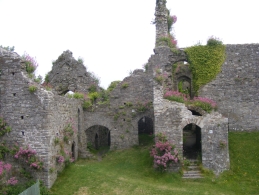 Just a short ride to Oystermouth castle on the Mumbles Bay using the very pleasant Clyne Valley cycle track. When we arrived, everything appeared to be locked, but Tony W spotted some surveyors inside who willingly let us in. This castle was probably originally built by William de Londres. There are wonderful views across Swansea Bay and over the town of Mumbles. The castle passed to the de Braose family in the 13th century and Edward I paid a brief visit here in 1284. The de Braose family rebuilt most of the castle in stone. On the east side of the castle is the chapel which is architecturally the high point - this was added in the early 14th century and is attributed to Lady Aline de Mowbray (nee de Braose) who married John de Mowbray.
Just a short ride to Oystermouth castle on the Mumbles Bay using the very pleasant Clyne Valley cycle track. When we arrived, everything appeared to be locked, but Tony W spotted some surveyors inside who willingly let us in. This castle was probably originally built by William de Londres. There are wonderful views across Swansea Bay and over the town of Mumbles. The castle passed to the de Braose family in the 13th century and Edward I paid a brief visit here in 1284. The de Braose family rebuilt most of the castle in stone. On the east side of the castle is the chapel which is architecturally the high point - this was added in the early 14th century and is attributed to Lady Aline de Mowbray (nee de Braose) who married John de Mowbray.
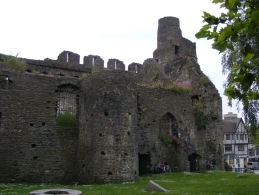 We cycled along the track following the curve of Swansea Bay until we reached the centre of the town. Just a few remains here of the castle - the owners, the de Braose family, preferred to live at Oystermouth - who can blame them! The visible remains of Swansea castle are probably the work of William de Braose III (grandfather of John de Braose).
We cycled along the track following the curve of Swansea Bay until we reached the centre of the town. Just a few remains here of the castle - the owners, the de Braose family, preferred to live at Oystermouth - who can blame them! The visible remains of Swansea castle are probably the work of William de Braose III (grandfather of John de Braose).
We then headed for Margam Abbey where we had lunch before heading off again for Bridgend. I had decided to give Kenfig Castle a miss as there is not much left. On reflection maybe we should have visited this castle established by Robert de Caen, Earl of Gloucester, in the first half of the 12th century. Robert granted the lands lying between the rivers Afan and Kenfig to the St Bernard's Cistercian abbey of Clairvaux in 1147 and they built Margam Abbey. After the dissolution, the Mansel family of Oxwich bought the Abbey in 1540 for their main place of residence - there are many elaborate tombs in the church to this family. Eventually the Mansell line became extinct in 1750 and the estates passed to the Rev Thomas Talbot of Lacock Abbey.
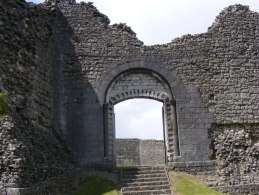 We arrived in Bridgend in mid afternoon and had a quick look at New Castle. The original castle first mentioned in 1106 marked the western limit of Robert FitzHamon's conquests. The present castle (it is not known whether it has been built on the same site as the original) was probably built in the late 12th century.
We arrived in Bridgend in mid afternoon and had a quick look at New Castle. The original castle first mentioned in 1106 marked the western limit of Robert FitzHamon's conquests. The present castle (it is not known whether it has been built on the same site as the original) was probably built in the late 12th century.
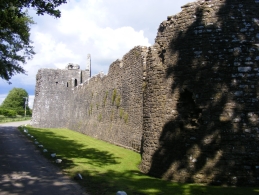 After a cup of tea and a "free" repair of one of my shoes where the stitching was starting to come apart, we made our way to Ewenny Priory on the south side of the town. The buildings, as you approach, look almost like a castle. I had no idea that this priory was founded by Maurice de Londres
After a cup of tea and a "free" repair of one of my shoes where the stitching was starting to come apart, we made our way to Ewenny Priory on the south side of the town. The buildings, as you approach, look almost like a castle. I had no idea that this priory was founded by Maurice de Londres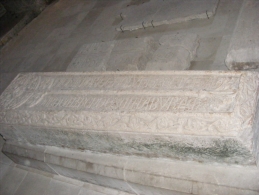 in 1141 as a cell of the Benedictine abbey of Gloucester, and that it contains tomb slabs of Maurice (shown on the right), his son William and grand-daughter Hawise (daughter of Thomas).
in 1141 as a cell of the Benedictine abbey of Gloucester, and that it contains tomb slabs of Maurice (shown on the right), his son William and grand-daughter Hawise (daughter of Thomas).
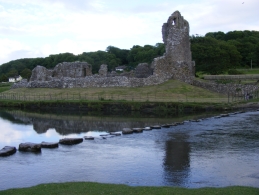 We dropped our bags off at the B&B in Ewenny and then cycled back to Bridgend for supper with Kim and Simon and family - my distant relatives of the Alderman family who share all these noble relatives and have returned from Canada to live in the UK. After this we then journeyed to Ogmore Castle, not far from Ewenny, built originally by William de Londres but later built in stone by Maurice (his son) in the early to mid 12th century. Another very fine castle picturesquely sitting beside the Ogmore river.
We dropped our bags off at the B&B in Ewenny and then cycled back to Bridgend for supper with Kim and Simon and family - my distant relatives of the Alderman family who share all these noble relatives and have returned from Canada to live in the UK. After this we then journeyed to Ogmore Castle, not far from Ewenny, built originally by William de Londres but later built in stone by Maurice (his son) in the early to mid 12th century. Another very fine castle picturesquely sitting beside the Ogmore river.
The mileage at the end of the day was 46.6 miles.
Castles visited - 4 plus Margam Abbey and Ewenny Priory